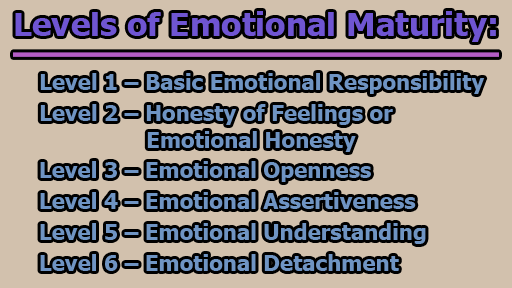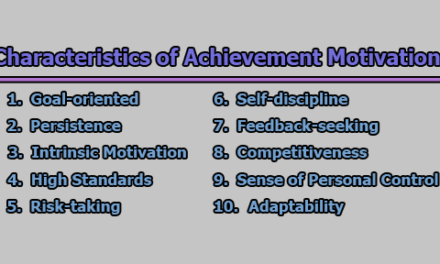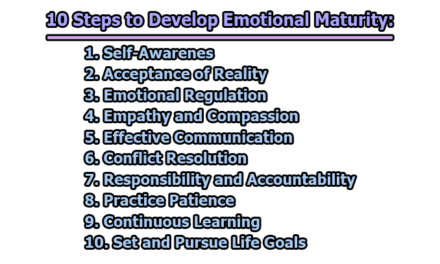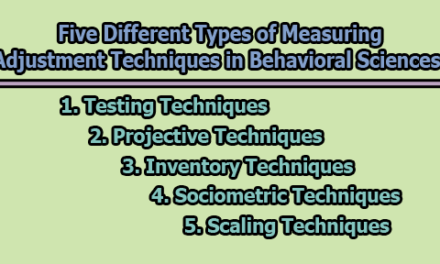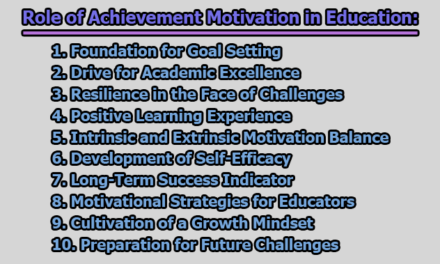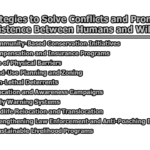Emotional Maturity:
Emotional maturity, a multifaceted construct, represents the pinnacle of psychological development, encapsulating an individual’s ability to navigate the complex terrain of emotions with resilience and grace. It is a dynamic process characterized by various components, including emotional stability, progression, social adjustment, personality integration, and independence. Contrary to the notion that age is the sole determinant of emotional maturity, it is influenced by life experiences, self-awareness, and the capacity to respond healthily to challenging situations. This nuanced interplay of psychological attributes contributes to the formation of emotionally mature individuals who exhibit adaptability, self-reliance, and a profound understanding of their own emotions and those of others. In the rest of this article, we will explore the definition, nature, components, characteristics, signs, and levels of emotional maturity.
Definition of Emotional Maturity:
According to Reber (1995), Emotional stability is a state of personality in which one is emotionally mature, whose emotional reactions are appropriate for the particular situation and are consistent from one set of circumstances to another.
According to Walter D. Smitson (1974), “Emotional maturity is a process in which the personality is continuously striving for greater sense of emotions, health, both inters physically and intra personally”.
According to Menninger (1999), “Emotional maturity can be defined as a process in which the personality always determined for better sense of emotional well-being”
According to Cole (1954), the most outstanding mark of emotional maturity is the ability to bear tension and it will enable a person to tolerate the frustration they undergo.
Nature of Emotions:
The nature of emotions is a deeply subjective, individual, personal, and intimate experience, providing a lens through which individuals navigate their world.
- Subjectivity and Individuality: Emotions are inherently subjective, varying from person to person based on individual experiences, perceptions, and personal histories. What might evoke joy in one individual could elicit sadness or fear in another. This subjectivity emphasizes the personal nature of emotional experiences, highlighting the unique ways in which individuals interpret and respond to stimuli.
- Conscious Liking and Disliking: Emotions are continually present in conscious experiences, influencing how individuals perceive and react to the world around them. They often denote states of satisfaction or dissatisfaction, liking or disliking specific situations, people, or events. This conscious aspect of emotions underscores their role in shaping preferences, values, and personal judgments.
- Complexity Beyond Feelings: While feelings are an integral part of emotions, the nature of emotions goes beyond simple affective states. Emotions involve a complex interplay of cognitive processes, physiological responses, and behavioral expressions. They encompass not only the conscious experience of feelings but also the underlying cognitive appraisals, bodily changes, and behavioral tendencies that collectively form the emotional response.
- Developmental Aspect: Emotions evolve and develop over time, influenced by both innate predispositions and environmental factors. As individuals grow and experience the world, their emotional repertoire expands, leading to more nuanced and sophisticated emotional responses. The developmental nature of emotions highlights their adaptability and role in shaping psychological growth.
- Educational Significance: The study of emotions holds significant educational value, as emotions influence learning, memory, and decision-making processes. Understanding the nature of emotions helps educators create supportive environments that cater to emotional well-being, fostering optimal conditions for cognitive and social development.
- Different Components: Emotions comprise various components, including cognitive thinking, physiological changes, expressive behaviors, and patterns of action. These components work in tandem to create a holistic emotional experience. Cognitive thinking involves the interpretation and appraisal of stimuli, physiological changes manifest in bodily responses, expressive behaviors include facial expressions and non-verbal cues, and patterns of action reflect behavioral tendencies associated with specific emotions.
- Adaptive Nature: Emotions are inherently adaptive, serving evolutionary purposes by helping individuals respond to challenges and opportunities in their environment. They provide a rapid and automatic way of processing information, guiding decision-making, and facilitating social interactions. Emotions, therefore, contribute to the overall adaptability and survival of individuals and communities.
Components of Emotion:
The components of emotion encompass a multifaceted interplay of cognitive, physiological, experiential, expressive, and behavioral elements. Understanding these components is crucial for comprehending the intricacies of human emotional experiences. Let’s delve into each component individually:
- Cognitive Thinking: The cognitive element of emotion revolves around the mental processes associated with our feelings. It suggests that emotions are often directed towards people or objects. For instance, if someone is experiencing a sense of worry, it may be because they perceive a situation as unsafe. This cognitive aspect involves our thoughts and interpretations of the circumstances, where we recognize the danger and assess it as more threatening than benign. In essence, our emotions are influenced by our cognitive appraisals of the world around us.
- Physiological: The physiological component of emotion delves into the bodily changes that accompany emotional experiences. These changes are often a result of heightened arousal in the sympathetic division of the autonomic nervous system or hormonal activity in the endocrine glands. For example, increased heart rate, changes in breathing patterns, and alterations in skin conductance are physiological responses that are commonly associated with emotional states. This component underscores the intricate connection between the mind and body in the realm of emotions.
- Experiential: The experiential component refers to the subjective feeling or sensation that arises due to stimuli affecting the sympathetic division of the autonomic nervous system or hormonal activity within the endocrine system. It involves the conscious experience of an emotion, encapsulating the sensory and affective aspects of the emotional state. This component is deeply personal and varies from individual to individual based on their unique perceptions and interpretations.
- Expressive: The expressive component encompasses outward manifestations of emotion, primarily through facial expressions and non-verbal behaviors such as bodily posture. Our emotions are often communicated to others through these expressive cues, allowing for social interaction and understanding. Facial expressions, for instance, can convey a wide range of emotions, serving as a visible representation of the internal emotional state.
- Behavioral: The behavioral component involves the patterns of behavior exhibited during an emotional state. Emotions, being dynamic internal states, prompt individuals to act in certain ways. These behavioral responses are adaptive and are geared towards the satisfaction and welfare of the individual. For example, feeling fear might lead to behaviors aimed at avoiding potential threats, while joy could result in engaging in activities that bring happiness.
Components of Emotional Maturity:
The components of emotional maturity, as outlined in the provided text, encompass various facets that contribute to an individual’s psychological well-being and adaptive functioning. Let’s explore each component:
- Emotional Stability: Emotional stability is a crucial component of emotional maturity. It refers to the characteristics of an individual that prevent excessive reactions or mood swings in response to emotive situations. An emotionally stable person can effectively navigate and respond appropriately to the demands of any given situation. Conversely, emotional instability signifies a tendency towards quick, unpredictable, and unreliable responses. This instability may manifest as irritability, stubbornness, and temper tantrums, reflecting a syndrome that challenges emotional resilience and adaptability.
- Emotional Progression: Emotional progression is a characteristic that denotes a sense of adequate advancement and growing vitality of emotions concerning the environment. It involves maintaining a positive outlook imbued with righteousness and contentment. This component reflects a person’s ability to evolve emotionally, demonstrating an adaptive response to life experiences. On the contrary, emotional regression encompasses factors such as restlessness, hostility, aggressiveness, and self-centeredness. It signifies a backward movement in emotional development, hindering positive growth and adaptability.
- Social Adjustment: Social adjustment refers to the process of interaction between an individual’s needs and the demands of the social environment in a given situation. Successful social adjustment enables individuals to maintain and adapt to desired relationships with their environment. This component emphasizes the importance of effective interpersonal skills and the ability to navigate social contexts to meet personal needs while aligning with societal expectations.
- Personality Integration: Personality integration is a crucial aspect of emotional maturity that involves the harmonious coactions and dissociation of inner conflicts within an individual. It reflects the alignment and coordination of one’s motives and dynamic tendencies, resulting in a cohesive and integrated personality. Achieving personality integration contributes to a stable and well-adjusted emotional state, allowing for more effective responses to various life situations.
- Independence: Independence is the capacity of an individual’s attitudinal tendency to be self-reliant and resistant to external control. An emotionally mature person with a high level of independence can make decisions based on their own judgment, utilizing facts and leveraging intellectual and creative potentialities. Independence in decision-making and actions signifies a level of autonomy and self-determination, contributing to overall emotional maturity.
Characteristics of Emotional Maturity:
Dr. Jerome Murray (2003) has delineated several key characteristics that define emotionally mature individuals. These characteristics provide insight into the psychological and behavioral aspects associated with emotional maturity:
- The Ability to Give & Receive Love: Emotional maturity is characterized by the capacity to give and receive love. Mature individuals create an environment of safety that allows for vulnerability. They express love wholeheartedly and are open to receiving love from others. This stands in contrast to immature individuals who may perceive expressions of love as signs of weakness, displaying egocentrism that focuses solely on accepting love without considering the reciprocal needs of others.
- The Ability to Face Reality & Deal with It: Emotional maturity is evident in one’s ability to confront and navigate the realities of day-to-day life. Mature individuals tackle problems and challenges in an ethical and effective manner. In contrast, immature individuals may avoid facing reality and delay addressing issues, revealing a lower level of maturity.
- Interested in Giving as Receiving: A mature person’s sense of personal safety translates into a positive inclination toward the well-being of others. They willingly invest their wealth, time, and effort to enhance the quality of life for themselves and those around them. In contrast, immature individuals may display imbalances, either being willing to give but reluctant to receive, or vice versa, demonstrating a lack of reciprocity.
- The Capacity to Relate Positively to Life Experiences: Emotionally mature individuals view life experiences as opportunities for learning. Whether positive or negative, these experiences contribute to personal growth. They derive pleasure from optimistic situations and take responsibility for negative ones, seeking opportunities for success.
- The Ability to Learn from Experience: Emotional maturity is closely linked to the ability to learn from experiences, whether positive or negative. Immature individuals may attribute experiences to luck or fate, failing to extract valuable lessons. In contrast, emotionally mature individuals actively learn and adapt based on their life experiences.
- The Ability to Accept Frustration: Mature individuals exhibit the capability to confront and handle situations that induce frustration. Instead of retreating or lamenting their fate, they persevere and explore alternative methods or directions to navigate through challenges.
- The Ability to Handle Hostility Constructively: When faced with frustration, emotionally mature individuals focus on problem-solving rather than blaming others. They channel their anger as energy to redouble their efforts in finding constructive solutions. In contrast, immature individuals tend to assign blame to others rather than addressing the root problems.
- Relative Freedom from Tension Symptoms: Emotional maturity is associated with a reduced presence of tension symptoms. Immature individuals may experience anxiety due to feelings of being unloved, avoiding reality, pessimism, and quick anger. On the contrary, mature individuals display a relaxed approach, demonstrating confidence in their ability to achieve their life expectations.
Signs of Emotional Maturity:
The signs of emotional maturity, as outlined by Dr. Jerome Murray (2003), provide a comprehensive understanding of the psychological and behavioral attributes associated with individuals who possess a high level of emotional maturity. Let’s explore the signs of emotional maturity:
- Flexibility: Emotional maturity is characterized by the ability to remain flexible and open-minded in various situations. Mature individuals understand that things may not always go as planned and are prepared to adapt. They create backup plans and maintain composure in the face of unexpected challenges. Importantly, they stay focused on their goals without being deterred by obstacles.
- Responsibility: Emotional maturity involves taking responsibility rather than blaming others for challenges or messes. Mature individuals exhibit humility and ground themselves, avoiding the tendency to find faults in people or circumstances. Instead, they focus on changing their perspectives and behavior to navigate through difficult situations.
- Limited Knowledge and Humility: Emotionally mature individuals display humility by acknowledging the limits of their knowledge. They are open to learning from others, recognizing that there is always room for improvement. This self-awareness allows them to be honest, self-reliant, and open-minded, valuing diverse perspectives and contributions from others.
- Openness to Learning: Emotional maturity involves the ability to turn weaknesses into strengths and view threats as opportunities. Mature individuals actively seek opportunities for learning in every situation. They ask questions that reflect a positive mindset, such as exploring ways to turn challenges in their favor and make improvements.
- Seeking Multiple Opinions: Emotionally mature individuals actively seek out opinions and viewpoints from others to gain a more comprehensive understanding. They approach disagreements with a calm demeanor, analyzing their own opinions in light of information provided by others. Their willingness to cross-check and validate their opinions contributes to well-informed decision-making.
- Resilience: Emotional maturity brings resilience in the face of setbacks and disappointments. Mature individuals acknowledge their feelings, validating them as genuine, and then resiliently fight back. They remain strong and find alternative ways to overcome obstacles, maintaining focus on their goals.
- Calm Disposition: Emotionally mature individuals maintain a calm and peaceful demeanor, preventing overreactions to provocation. They manage their emotions effectively, ensuring that rational thinking prevails even in challenging situations. Their clarity of thought prevents emotions from clouding their judgment.
- Defining Egocentric Behavior: Emotional maturity requires setting aside egocentric tendencies. Mature individuals possess a realistic sense of self, understanding the balance between their own needs and the needs of others in social interactions. They remain open to others’ opinions and needs, devoid of false egos and pride, relying on patience to navigate through difficulties.
- Defying Critical Evaluation: Emotionally mature individuals exhibit easygoing, understanding, and considerate behavior. They prefer humble communication, avoiding criticism and judgments. Empathy is a key trait in their personality, as they seek to understand others without passing judgment based on assumptions or preconceived ideas.
- A Good Sense of Humor: Individuals with emotional maturity possess a great sense of humor, enabling them to navigate through stress with laughter. This ability reflects higher emotional intelligence and the skill to handle tense situations with ease and enjoyment.
Levels of Emotional Maturity:
Levels of emotional maturity represent a developmental process that individuals undergo as they learn to navigate and respond to diverse experiences in their daily lives. The concept challenges the notion that age is the sole determinant of emotional maturity, highlighting that life experiences and one’s ability to respond healthily to challenging situations play crucial roles. The six levels of emotional maturity are as follows:
Level 1 – Basic Emotional Responsibility: At this initial level, individuals begin the journey towards emotional maturity by taking responsibility for their own emotions. They no longer attribute their emotional states to external factors and refrain from blaming others for their feelings or reactions. Expressions like blaming and labeling emotions as good or bad are discarded at this stage. The focus is on understanding and owning one’s emotional responses.
Level 2 – Honesty of Feelings or Emotional Honesty: Moving beyond basic responsibility, this level signifies the ability to accept feelings without judgment. Individuals reach a point where they feel free to experience emotions without suppressing or hiding them. Emotional honesty becomes a key aspect, and individuals acknowledge negative feelings as a natural part of being human. There is a genuine and authentic expression of emotions without pretense.
Level 3 – Emotional Openness: Emotional openness involves a willingness to embrace the feelings of others in a more empathetic manner. Individuals at this level act flexibly and consider the emotions of others as genuine and authentic within the given scenario. This level reflects an expanded awareness and sensitivity to the emotional experiences of those around them.
Level 4 – Emotional Assertiveness: At this stage, individuals develop a heightened awareness of their emotional needs and the ability to express them openly. Emotional assertiveness involves articulating one’s feelings and needs with confidence. This level signifies the capability to communicate emotional requirements openly, fostering healthy interpersonal relationships.
Level 5 – Emotional Understanding: Emotional understanding represents a deeper level of development where individuals gain clarity on the cause and effect of their emotional responses. They take full responsibility for their emotions by understanding the factors that contribute to their feelings. This level involves self-awareness and the ability to connect emotions with their underlying sources.
Level 6 – Emotional Detachment: The pinnacle of emotional maturity is reached at level 6, where individuals attain the ability to detach from disruptive and distressing feelings. They develop the maturity to let go of emotions that cause turmoil and stress, maintaining inner peace. Emotional detachment involves a conscious choice to distance oneself from negative emotions, leading to greater resilience and equilibrium.
In conclusion, the journey towards emotional maturity is a continual process marked by self-reflection, growth, and the integration of various components. As individuals progress through the levels of emotional responsibility, honesty, openness, assertiveness, understanding, and detachment, they foster a resilient and well-balanced emotional state. Emotional maturity allows individuals to respond to life’s challenges with wisdom, maintaining composure in the face of adversity, and fostering harmonious relationships. By cultivating emotional maturity, individuals not only enhance their own well-being but also contribute positively to the social fabric, creating a more empathetic and interconnected world.

Former Student at Rajshahi University

